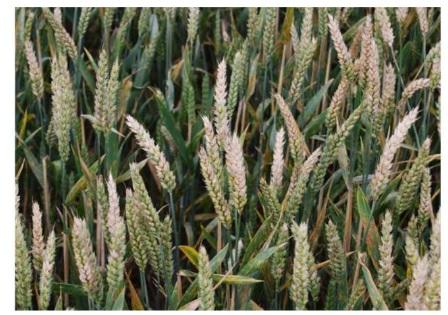Harmful fungal toxins in wheat are a growing threat, says study
Published: December 26, 2022
Source : https://phys.org/news/2022-12-fungal-toxins-wheat-threat.html

Wheat—the most widely cultivated crop in the world—is under growing attack from harmful toxins. Across Europe, almost half of wheat crops are impacted by the fungal infection that gives rise to these toxins, according to a study led by fungal biologist Dr. Neil Brown from the U.K.'s University of Bath, in collaboration with colleagues at the University of Exeter.
These troublesome "mycotoxins" are produced by the fungus that causes Fusarium Head Blight, a disease that affects wheat and other cereals growing in the field. Eating products contaminated with mycotoxins causes sickness in humans and livestock, such as vomiting and other gastrointestinal problems. Mycotoxins are also bad news for farmers and the economy because they reduce the grain's value.
Wheat plays a huge role in feeding humanity, providing 18% of the total calories in people's diets globally. Concerns both for our health and for global food supplies were the impetuses for the new study.
Dr. Brown, who works in the Milner Center for Evolution in the Department of Life Sciences at Bath, said, "Contaminated crops and Fusarium toxins are always a worry, as they pose a significant threat to our health, especially as we only partially understand their effects on our well-being."
"But on top of these health concerns, we must remember that wheat is a hugely important global crop, so it's essential for us to maintain high yields along with safe food production—not least because climate change, and now the war in Ukraine (the world's fourth largest exporter of wheat), are already impacting on wheat yields and grain prices."
Preventing toxin contaminations is therefore important both to help maintain the stable price of wheat and to protect our food security, ensuring global stability.
Fungal toxins present in almost half of wheat
In their study published in Nature Food, the research team examined the largest datasets available from governments and agribusiness, both of which monitor Fusarium mycotoxins in wheat grain entering our food and animal feed supply chains. By using data from across Europe (including the U.K.) from the past 10 years, the team built the most complete picture yet of the mycotoxin threat and how it is changing.
Fusarium mycotoxins were discovered in every European country. Half of the wheat intended for human food in Europe contains the Fusarium mycotoxin "DON" (commonly referred to as vomitoxin) while in the U.K., 70% of wheat is contaminated. Governments set legal limits on DON contamination levels in wheat that is to be consumed by humans.
These regulations provide effective protection, with 95% of wheat destined for the table meeting the safety limits for DON concentration. However, the finding that mycotoxins are ubiquitous is concerning, as the effect of constant, low-level exposure to mycotoxins in our diet over the course of a lifetime is not known.
"There are real concerns that chronic dietary exposure to these mycotoxins impacts human health," said Dr. Brown.
The high cost of toxins
When mycotoxins reach a certain level, the contaminated grain is diverted from human food to animal feed. "This comes at a cost to the cereal farmer, impacts cereal market prices, and shifts the health problem to our livestock," said Dr. Brown.
Consequently, the team found worryingly high levels of DON mycotoxin in wheat fed to livestock.
Ms. Louise Johns, a Ph.D. student in Dr. Brown's group, said, "It's far higher than in human food. This is a concern for animal health, but it also paints a picture of what mycotoxin levels in food wheat could look like without current regulations."
For the first time, the Bath team has put a price on the impact of Fusarium Head Blight mycotoxins by estimating the value lost due to wheat being too contaminated with DON for human consumption.
To read the complete report, go to https://phys.org/news/2022-12-fungal-toxins-wheat-threat.html.
Source
https://phys.org/news/2022-12-fungal-toxins-wheat-threat.htmlRelated topics:
Recommend
Comment
Share

Would you like to discuss another topic? Create a new post to engage with experts in the community.





.jpg&w=3840&q=75)